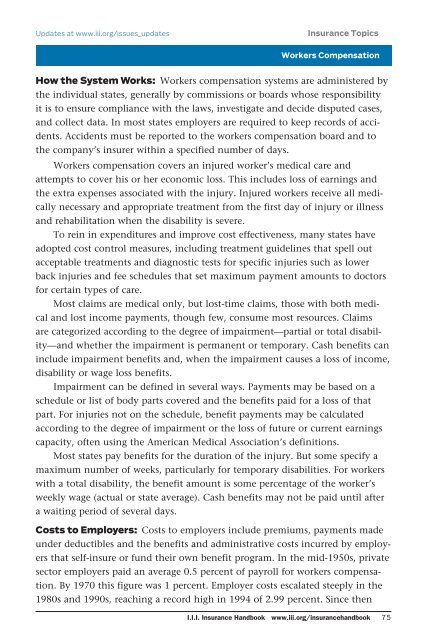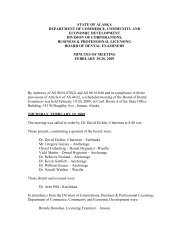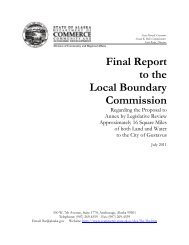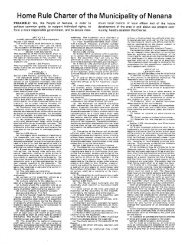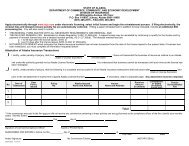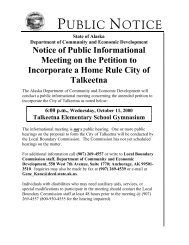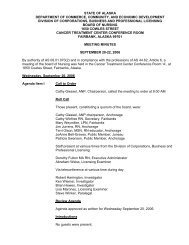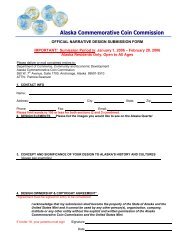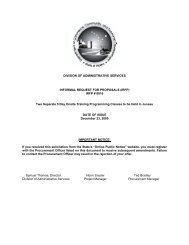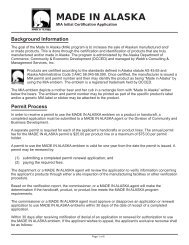Insurance Handbook - Alaska Department of Community and ...
Insurance Handbook - Alaska Department of Community and ...
Insurance Handbook - Alaska Department of Community and ...
Create successful ePaper yourself
Turn your PDF publications into a flip-book with our unique Google optimized e-Paper software.
Updates at www.iii.org/issues_updates <strong>Insurance</strong> Topics<br />
Workers Auto Compensation<br />
<strong>Insurance</strong><br />
How the System Works: Workers compensation systems are administered by<br />
the individual states, generally by commissions or boards whose responsibility<br />
it is to ensure compliance with the laws, investigate <strong>and</strong> decide disputed cases,<br />
<strong>and</strong> collect data. In most states employers are required to keep records <strong>of</strong> accidents.<br />
Accidents must be reported to the workers compensation board <strong>and</strong> to<br />
the company’s insurer within a specified number <strong>of</strong> days.<br />
Workers compensation covers an injured worker’s medical care <strong>and</strong><br />
attempts to cover his or her economic loss. This includes loss <strong>of</strong> earnings <strong>and</strong><br />
the extra expenses associated with the injury. Injured workers receive all medically<br />
necessary <strong>and</strong> appropriate treatment from the first day <strong>of</strong> injury or illness<br />
<strong>and</strong> rehabilitation when the disability is severe.<br />
To rein in expenditures <strong>and</strong> improve cost effectiveness, many states have<br />
adopted cost control measures, including treatment guidelines that spell out<br />
acceptable treatments <strong>and</strong> diagnostic tests for specific injuries such as lower<br />
back injuries <strong>and</strong> fee schedules that set maximum payment amounts to doctors<br />
for certain types <strong>of</strong> care.<br />
Most claims are medical only, but lost-time claims, those with both medical<br />
<strong>and</strong> lost income payments, though few, consume most resources. Claims<br />
are categorized according to the degree <strong>of</strong> impairment—partial or total disability—<strong>and</strong><br />
whether the impairment is permanent or temporary. Cash benefits can<br />
include impairment benefits <strong>and</strong>, when the impairment causes a loss <strong>of</strong> income,<br />
disability or wage loss benefits.<br />
Impairment can be defined in several ways. Payments may be based on a<br />
schedule or list <strong>of</strong> body parts covered <strong>and</strong> the benefits paid for a loss <strong>of</strong> that<br />
part. For injuries not on the schedule, benefit payments may be calculated<br />
according to the degree <strong>of</strong> impairment or the loss <strong>of</strong> future or current earnings<br />
capacity, <strong>of</strong>ten using the American Medical Association’s definitions.<br />
Most states pay benefits for the duration <strong>of</strong> the injury. But some specify a<br />
maximum number <strong>of</strong> weeks, particularly for temporary disabilities. For workers<br />
with a total disability, the benefit amount is some percentage <strong>of</strong> the worker’s<br />
weekly wage (actual or state average). Cash benefits may not be paid until after<br />
a waiting period <strong>of</strong> several days.<br />
Costs to Employers: Costs to employers include premiums, payments made<br />
under deductibles <strong>and</strong> the benefits <strong>and</strong> administrative costs incurred by employers<br />
that self-insure or fund their own benefit program. In the mid-1950s, private<br />
sector employers paid an average 0.5 percent <strong>of</strong> payroll for workers compensation.<br />
By 1970 this figure was 1 percent. Employer costs escalated steeply in the<br />
1980s <strong>and</strong> 1990s, reaching a record high in 1994 <strong>of</strong> 2.99 percent. Since then<br />
I.I.I. <strong>Insurance</strong> <strong>H<strong>and</strong>book</strong> www.iii.org/insuranceh<strong>and</strong>book 75


